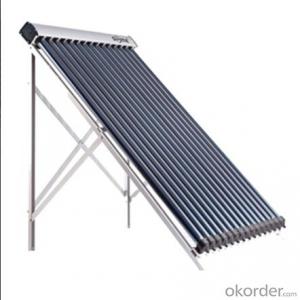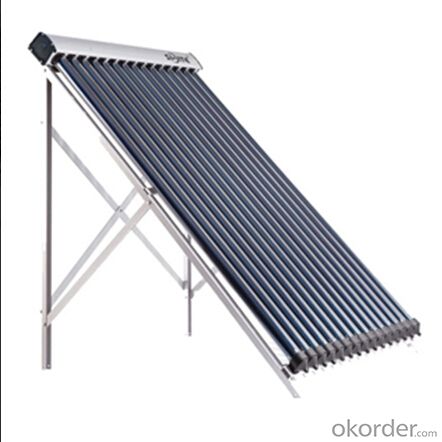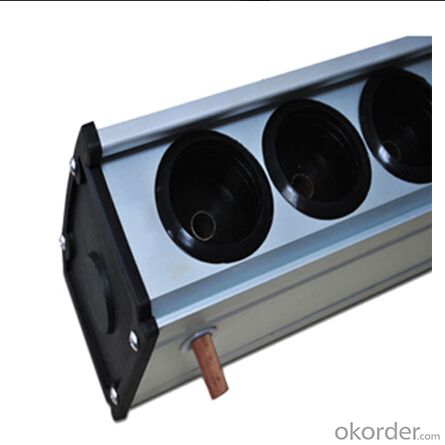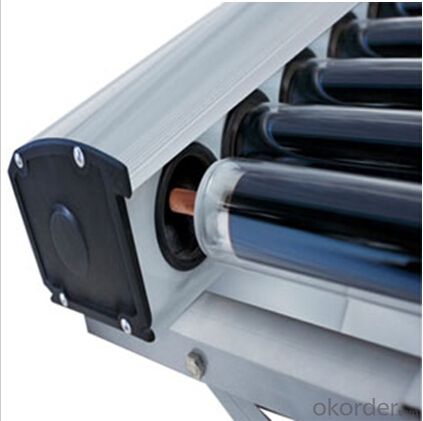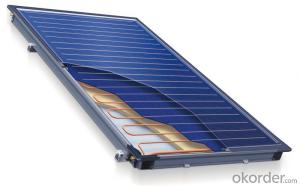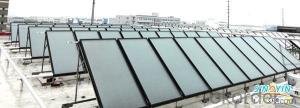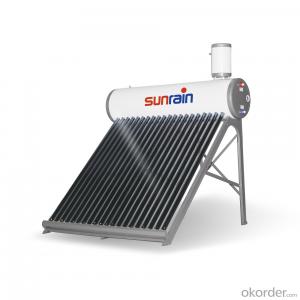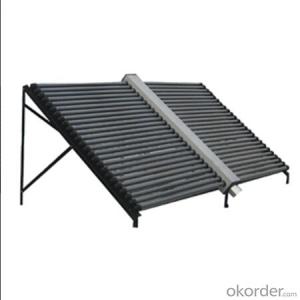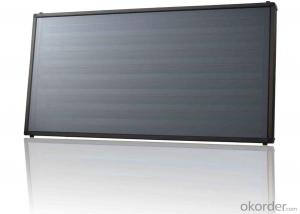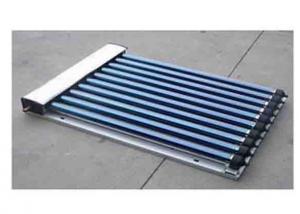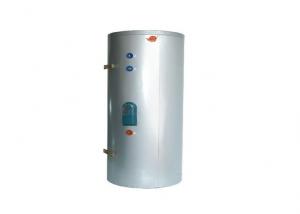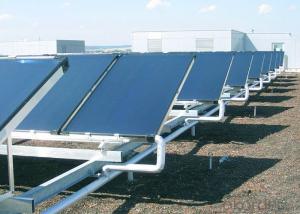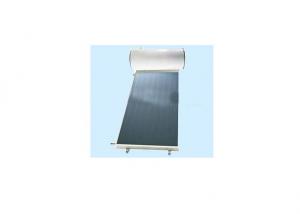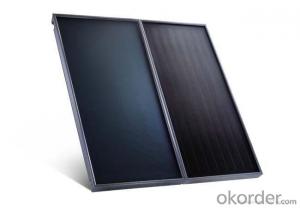Non Concentrating Solar Collectors - Inlet and Outlet at the Bottom of Manifold SC-HD
- Loading Port:
- Shanghai
- Payment Terms:
- TT OR LC
- Min Order Qty:
- 1 set
- Supply Capability:
- 2500 set/month
OKorder Service Pledge
OKorder Financial Service
You Might Also Like
1. Structure of Inlet and Outlet at the bottom of Manifold Solar Collector Model SC-HD Description:
This product is composed of Aluminium alloy for frame, rock wool for the insulation,tri-element vacuum glass tube and antifreeze heat pipe.It can often be used in subzero temperatures without the system sustaining damage. Flat plate systems often require expensive and complicated "antifreeze" systems to be installed.
2. Main Features of Inlet and Outlet at the bottom of Manifold Solar Collector Model SC-HD
1) The inlet and outlet be opened on the bottom of manifold; It looks more artistic than trandithional manifold;
2) Good sealed in end of cover, It can provide higher insulation efficiency;
3) The most advantage is that It can be Emptyed the medium( water or deicing fluid) in the Manifold;
3. Inlet and Outlet at the bottom of Manifold Solar Collector Model SC-HD Images
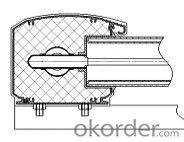
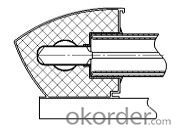
4. Inlet and Outlet at the bottom of Manifold Solar Collector Model SC-HD Specifications
Model | SC-HD-10 | SC-HD-15 | SC-HD-18 | SC-HD-20 | SC-HD-24 | SC-HD-25 | SC-HD-30 |
SC-H1-10 | SC-H1-15 | SC-H1-18 | SC-H1-20 | SC-H1-24 | SC-H1-25 | SC-H1-30 | |
Vacuum tube quantity(pcs) | 10 | 15 | 18 | 20 | 24 | 25 | 30 |
Tube spacing (㎜) | 75 | 75 | 75 | 75 | 75 | 75 | 75 |
Vacuum tube diameter/length (㎜) | φ58/1700 | φ58/1700 | φ58/1700 | φ58/1700 | φ58/1700 | φ58/1700 | φ58/1700 |
Vacuum tube material | high borosilicate glass 3.3 | high borosilicate glass 3.3 | high borosilicate glass 3.3 | high borosilicate glass 3.3 | high borosilicate glass 3.3 | high borosilicate glass 3.3 | high borosilicate glass 3.3 |
Vacuum tube inner/outer pipe wall thickness (㎜) | 1.6/1.8 | 1.6/1.8 | 1.6/1.8 | 1.6/1.8 | 1.6/1.8 | 1.6/1.8 | 1.6/1.8 |
Heat pipe condensing end diameter/length (㎜) | φ14/1750 | φ14/1750 | φ14/1750 | φ14/1750 | φ14/1750 | φ14/1750 | φ14/1750 |
heat pipe material/wall thickness (㎜) | Copper tp2/0.6 | Copper tp2/0.6 | Copper tp2/0.6 | Copper tp2/0.6 | Copper tp2/0.6 | Copper tp2/0.6 | Copper tp2/0.6 |
inner tank diameter/wall thickness (㎜) | φ35/1.0 | φ35/1.0 | φ35/1.0 | φ35/1.0 | φ35/1.0 | φ35/1.0 | φ35/1.0 |
connector size | φ22 or 3/4″ | φ22or 3/4″ | φ22or 3/4″ | φ22or 3/4″ | φ22or 3/4″ | φ22or 3/4″ | φ22or 3/4″ |
collector insulation material/thickness (㎜) | Rock wool/40 | Rock wool/40 | Rock wool/40 | Rock wool/40 | Rock wool/40 | Rock wool/40 | Rock wool/40 |
solar collector rated pressure (MPa) | 0.6 | 0.6 | 0.6 | 0.6 | 0.6 | 0.6 | 0.6 |
collector operating temperature ℃ | <100 | <100 | <100 | <100 | <100 | <100 | <100 |
collector volume (L) | 0.69 | 0.98 | 1.15 | 1.27 | 1.50 | 1.56 | 1.85 |
collector aperture area (㎡) | 1.0 | 1.5 | 1.8 | 2.0 | 2.4 | 2.5 | 3.0 |
collector total area (㎡) | 1.56 | 2.30 | 2.74 | 3.04 | 3.63 | 3.77 | 4.51 |
referral traffic (L/min) | 0.75 | 1.13 | 1.35 | 1.50 | 1.81 | 1.88 | 2.26 |
intensity pressure (Pa) | 23.2 | 59.2 | 90.6 | 116.7 | 181.7 | 200.2 | 314.0 |
intercept efficient η0 | 0.744 | 0.744 | 0.744 | 0.744 | 0.744 | 0.744 | 0.744 |
heat loss coefficient a | 2.09 | 2.09 | 2.09 | 2.09 | 2.09 | 2.09 | 2.09 |
collector power (W)1000W/㎡ irradiation | 620 | 870 | 1047 | 1165 | 1401 | 1457 | 1748 |
collector net weight (kg) | 38.25 | 50.75 | 59.75 | 64.75 | 79.00 | 83.35 | 98.70 |
a (㎜) | 895 | 1270 | 1495 | 1645 | 1945 | 2020 | 1395 |
b (㎜) | 800 | 1175 | 1400 | 1550 | 1850 | 1925 | 2300 |
c (㎜) | 725 | 1100 | 1325 | 1475 | 1775 | 1850 | 2225 |
c/2 (㎜) | —— | —— | —— | —— | 887.5 | 925 | 1112.5 |
d (㎜) | 1980 | 1980 | 1980 | 1980 | 1980 | 1980 | 1980 |
e (㎜) | 1240 | 1240 | 1240 | 1240 | 1240 | 1240 | 1240 |
f (㎜) | 1470 | 1470 | 1470 | 1470 | 1470 | 1470 | 1470 |
5. FAQ
(1) Which collector is the best value for money?
Rather than looking at just peak efficiency levels when comparing solar collectors, cost per unit of energy produced is much more logical. For example: Although collector A may be 20% more efficient than collector B, if collector A is 30% more expensive, then in fact collector B may be a better choice, as per kWh of energy produced per day it is cheaper. When payback time is of concern, not only price per kWh of the product is important, but also of the end system.
(2) Can this solar collectors be used for a large scale hot water production?
Yes. This solar collectors can be connected in series or parallel to provide large scale hot water production for a commercial settings such as a school, hotel or office building. There is really no limit to the size of the system, however collectors must be installed in banks of no more than 150 tubes (in series), otherwise the water may boil.
(3) What maintenance of the solar collector is required?
Under normal circumstances no maintenance of the system is required. Due to the shape of the tubes regular rainfall and wind should keep the tubes clean. Should a tube even be broken it should be replaced. This, however, is an inexpensive and easy job. Any "handy" person can install a new tube (while adhering to local health and safety regulations). Sidite solar collectors can operate with several broken tubes, however the efficiency will be reduced slightly.
- Q: Can solar collectors be used in areas with high levels of dust or dirt?
- Yes, solar collectors can be used in areas with high levels of dust or dirt. However, the efficiency of the solar collectors may be impacted as the accumulation of dust or dirt can reduce the amount of sunlight reaching the surface of the collectors. Regular cleaning and maintenance of the collectors may be necessary to ensure optimal performance in such areas.
- Q: Do solar collectors require maintenance?
- Yes, solar collectors do require maintenance. Regular maintenance is necessary to ensure optimal performance and longevity of the solar collectors. This includes cleaning the panels to remove dust and debris, checking for any damage or leakage, inspecting the connections and wiring, and monitoring the system's performance. Additionally, some components may need to be replaced or repaired over time.
- Q: Can solar collectors be used for generating electricity on robots?
- Yes, solar collectors can be used for generating electricity on robots. Solar collectors, also known as solar panels or photovoltaic cells, convert sunlight into electrical energy. These panels can be installed on the surface of a robot, allowing it to harness solar energy and generate electricity to power its various functions and systems. This renewable energy source is particularly useful for robots operating in remote or off-grid locations where access to conventional power sources may be limited. Solar-powered robots can be employed in a variety of applications, such as exploration, surveillance, agriculture, and even domestic tasks. Additionally, advancements in solar technology have led to more efficient and compact solar panels, making them an increasingly viable option for powering robots.
- Q: How long does it take for a solar collector to reach optimal temperature?
- The time it takes for a solar collector to reach optimal temperature can vary depending on factors such as the size and type of collector, the amount of sunlight available, and the temperature of the surroundings. Generally, it can take anywhere from 30 minutes to a couple of hours for a solar collector to reach its optimal temperature.
- Q: Are there any challenges in integrating solar collectors with existing heating systems?
- Yes, there are several challenges in integrating solar collectors with existing heating systems. One of the main challenges is the compatibility of the existing system with the solar collectors. The heating system may need to be modified or upgraded to accommodate the solar collectors and effectively utilize the solar energy. Additionally, the installation process can be complex and require professional expertise. Furthermore, the intermittent nature of solar energy availability can pose challenges in achieving a consistent and reliable heating output. Adequate storage systems or backup heating sources may be needed to compensate for periods of low solar radiation.
- Q: How do solar collectors compare to traditional fossil fuel-based heating systems in terms of emissions?
- Solar collectors are far superior to traditional fossil fuel-based heating systems when it comes to emissions. Fossil fuel-based heating systems, such as those that rely on burning coal, oil, or natural gas, emit large amounts of greenhouse gases, primarily carbon dioxide (CO2), which contribute to global warming and climate change. On the other hand, solar collectors generate heat by harnessing the sun's energy, which produces no direct emissions or pollution. By using solar collectors for heating, we can significantly reduce our carbon footprint and mitigate the negative impact on the environment. Solar energy is a renewable and clean source of power, ensuring that no harmful pollutants are released into the atmosphere during its generation. This makes solar collectors a crucial component in transitioning to a more sustainable and eco-friendly future. Furthermore, solar collectors do not require any ongoing fuel supply, as they solely rely on the abundant and free energy from the sun. In contrast, fossil fuel-based systems are dependent on the extraction, transportation, and burning of fossil fuels, which not only depletes finite resources but also contributes to air pollution and environmental degradation. In summary, solar collectors outshine traditional fossil fuel-based heating systems in terms of emissions. They offer a sustainable and environmentally friendly alternative, helping to combat climate change, reduce air pollution, and preserve our planet for future generations.
- Q: Are solar collectors easy to install?
- Yes, solar collectors are generally easy to install. They can be installed on rooftops or mounted on the ground with minimal effort. With proper instructions and basic knowledge of electrical connections, most homeowners or professionals can successfully install solar collectors.
- Q: Are solar collectors suitable for heating museums and art galleries?
- Yes, solar collectors are suitable for heating museums and art galleries. They provide a sustainable and cost-effective method of heating, while also ensuring a consistent and comfortable indoor climate for preserving delicate artworks and artifacts. Additionally, solar collectors can be integrated into the architectural design of the building without compromising its aesthetics.
- Q: Can solar collectors be used in areas with limited access to government assistance?
- Yes, solar collectors can be used in areas with limited access to government assistance. Solar energy is a renewable resource that can be harnessed independently of government programs or subsidies. With the right infrastructure and technology, solar collectors can provide a reliable source of electricity and heating in areas with limited government support, helping to reduce dependence on traditional energy sources and improve energy access in remote or underserved communities.
- Q: How do evacuated tube solar collectors work?
- Evacuated tube solar collectors work by utilizing a vacuum-sealed glass tube design to harness the sun's energy. These tubes consist of two concentric glass layers, with the outer layer being transparent and the inner layer being coated with a selective absorber material. When sunlight enters the tube, it is absorbed by the selective absorber, converting the solar energy into heat. The vacuum insulation minimizes heat loss, allowing the absorbed heat to be transferred to a fluid (usually water or a heat transfer fluid) flowing through a metal tube within the inner glass layer. This heated fluid can then be utilized for various applications such as heating water or space, or even generating electricity through a heat exchanger or a power turbine.
Send your message to us
Non Concentrating Solar Collectors - Inlet and Outlet at the Bottom of Manifold SC-HD
- Loading Port:
- Shanghai
- Payment Terms:
- TT OR LC
- Min Order Qty:
- 1 set
- Supply Capability:
- 2500 set/month
OKorder Service Pledge
OKorder Financial Service
Similar products
Hot products
Hot Searches
Related keywords
